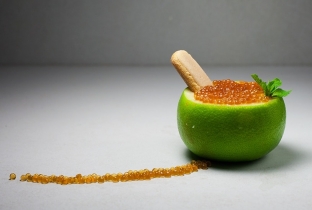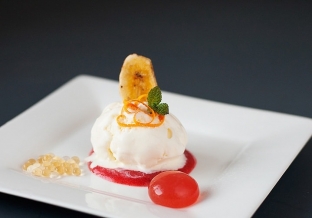Molecular cuisine – absolutely unique type of cooking, designed to excite the taste and interest of the consumer. The goal of the creative creators of molecular cuisine – to surprise the consumer, to make his senses work more intensively, to give pleasure more than usual, to meet the expectations of a person, revealing new taste facets to him through molecular recipes. The molecular chef does not hide that he intends to impress you: “Food– it's not at all what you thought. Food – it's something you might think about if you let your fantasy run wild”.
Molecular recipes: features of the molecular approach to dishes
- Forms. Molecular chefs create spheres, foams, gases, solid liquids and other unusual things for an innovative approach to the usual meal. The results of cooking dishes according to molecular recipes are impressive: carrot caviar, gel tea or bizet ice cream can be found on the same table.
- Toolbox. The equipment for bringing molecular recipes to life is fundamentally different from the usual kitchen tools. Instead of an abundance of dishes – retorts and flasks instead of plates – spoons, and plates – often convective. Cylinders, centrifuges, vacuum devices, lasers and all kinds of para-science gadgets delight and amaze.
- Technology. Prepared according to molecular recipes using chemicals, refrigerants, etc. For example, frying on water, smell and essence for dessert from a retort and an alembic. Incredible combinations of temperature regimes and cooking time for the usual cuisine are created – from a couple of seconds to several days. Liquid nitrogen, dry ice, centrifuge, pipettes and syringes – what virtuoso chefs don't work with.
- Cooking time. Depending on the final desired result, the dishes are cooked slowly or quickly. Instant freezing and multi-day pickling – just the effect of time – and what striking changes: hard drinks, meat foams and gaseous herbs!
- Proportions. The main condition of molecular cuisine – precision in everything. There are no minor details and unnecessary products. Time is calculated to fractions of seconds, weight – to milligrams and ounces.
- Expensive. Of course, not every restaurant or amateur chef can afford to purchase all the necessary tools and reagents needed to cook dishes according to molecular recipes. The price for the full functioning of the molecular kitchen varies from 20 euros to several thousand. Add here the cost of products and salary payments for a specialist – good is expensive. But at the exit, a restaurant or a home craftsman offers the enjoyment of the quintessence of taste and aroma.
Molecular Recipes: Ferification – giving round shapes to ordinary dishes
Molecular cuisine creates an ambiguous impression. Of course, it all depends on the imagination of the chef and the requests of the guests. The results of such creative flights give rise to molecular recipes-masterpieces worthy of participating in art exhibitions. One of the business cards of such installations in a spoon – this is spherification. Spherification is quite simple: sodium alginate is added to the main product, and then poured into water with calcium chloride by dripping. Drops of fresh or broth take the form of spheres, elastic and filled with their own taste. They burst on the tongue, filling the mouth with pure taste: meat, fish, vegetables or fruits. There is an explosion of taste on the tongue. Molecular cuisine turns ordinary products into a virtuoso masterpiece of any diameter.
Molecular dessert recipes: spherical fruits and berries
The usefulness of fruit rich in vitamins has long been known and proven. Mango – tropical wonder with a mixed taste of melon, pumpkin, carrot, vanilla – who sees something in this juicy, sweet fruit. Let's go beyond taste definitions and reshape the mango dessert using the following molecular recipe.
Mango Orbs
Ingredients:
- 250 ml water;
- 1.3 gr. citrate;
- 1.8 gr. alginate;
- 250 gr. mango puree;
for calcium water
- 6.5 gr. calcium;
- 1 l. water.
- Prepare Citrate in 250 ml of water, mix with Alginate. Mix until completely dissolved.
- Bring to a boil. Cool to room temperature.
- Introduce mashed potatoes, beat well with a mixer. Place in refrigerator to remove air bubbles. (Any mango puree will do, even frozen ones.)
- Prepare calcium water (dissolve Calcium in water by mixing with a blender). Place the mixture in a deep tray (no smaller than 5 cm).
- Fill a hemisphere spoon with the puree, then pour it into the calcium water. Leave the sphere to harden for a couple of minutes and rinse in cold water. Strain.
- Sprinkle with ground nuts or flaked coconut to garnish.

Let's mix seemingly different ingredients for a new taste of a familiar dessert in a molecular recipe.
Strawberry spheres with ground pepper
Ingredients:
- 250 gr. strawberry puree;
- 10 gr. sugar;
- salt;
- 5 gr. gluconate;
- strawberry fresh (for storing spheres in the fridge).
For alginate water:
- 1 l. water;
- 5 gr. Alginate.
To serve:
- ground pepper.
- For alginate water you need 300 ml of water and 5 gr. Alginate. Stir until dissolved, using a blender and the rest of the water. Put the finished solution in the refrigerator to remove air bubbles.
- Mix puree with gluconate.
- Dip a hemispherical spoon with puree into alginate water for a couple of minutes until the shell hardens.
- Remove the spheres and rinse in clean water.
- Dry the product and serve on serving spoons or rosettes, sprinkled with pepper.







Add a comment